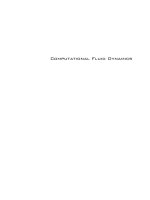Computational Fluid Dynamics Harasek Part 4 pot
Bạn đang xem bản rút gọn của tài liệu. Xem và tải ngay bản đầy đủ của tài liệu tại đây (2.51 MB, 30 trang )
Model Reference
c
y
DND
D
c
y
y
DPND
P
D
co
o
y
y
DPND
P
D
P
D
DHD
y
DP H
DD
2
y
f
y
DND P
N
D
PN D PN D
DH
v v
v v
D
c
D
P
y
P
y
P
y
D
c
T D
c
D P
y
D
c
D P
y
H
c
D
c
D
c
T
H
N
D
z
D
zr
D
z
z
QrvrDvz
D v
r
v
z
z
z
Q
D
z
Q
rv r
ND ND
Impeller
Parameter A100 A200 A310
v
z
r
z
z
Q
rv r
ND ND
Q
c
z
v
r
c
P
P
z
r
D
z
Q
vz
ND ND
t
CC
m
C
C C
m
mvmm
t
m v
C
C
CC
t
Pt D Nt
Pt D
Dt
Nt
Nt
Nt
Pt D
Pt D
tND
ND
t
N D
Ts
Ts
f
Re s
fe
G
s
Re s
G
f
R
T T
vQ d Q
d
f
V V
Qf
V
VV
Q
0.5% xanthan gum 1.5% xanthan gum
Parameter Experiment CFD Experiment CFD
f
VV
f
VV
Impeller Experiment CFD Experiment CFD
Chem. Eng. Sci.
Chem. Eng. Sci.
J. Phys. E: Sci.
Instrum.
Chem. Eng. Res. Des.
J. Exp. Thermal Fluid Sci.
Transport Phenomena
Chem. Eng.
Sci
Chem. Eng. Res. Des.
Exp. Fluids
Macroscale Mixing and Dynamic Behavior of Agitated Pulp Stock Chests
Appita J.
TAPPI J
Can. J. Chem. Eng
J. Pulp Paper Can.
Chem. Eng. Sci
Chem. Eng. Res. Des
TAPPI J.
Chem. Eng. Res. Des.
Proceedings of 6th European
Conference on Mixing
Chem. Eng. Sci.
AIChE J
AIChE J
Biotechnol. Prog
Chem. Eng. Technol
Bioproc. Eng
Mixing in the Process Industries
IChem. E. Symp
Chem. Eng. Res. Des
Chem. Eng. Tech
Proceedings of CHISA 93
Chem. Eng. Res. Des.
J. Process
Control
Int. Chem. Eng.
Chem. Eng. Sci.
Chem. Eng. Res Des.
Ind. Eng.
Chem. Res
Chem. Eng. J.
Chemical Reaction Engineering
Chem. Eng. Res. Des
Inst. Chem. Eng. Sympo. Ser.
Rheology: Principles, Measurements and Applications
Chem. Eng. Res. Des.
Ultrasonics
AIChE J
Turbulence, Vibrations, Noise and Fluid
Instabilities. Practical Approach.
Dr. Carlos Gavilán Moreno
Cofrentes N.P.P. Iberdrola S.A.
Spain
1. Introduction
Colloquially speaking, turbulence in any language means disorderly, incomprehensible, and
of course, unpredictable movement. Consequently, we encounter expressions that employ
the word turbulence in social and economic contexts; in aviation whenever there are
abnormalities in the air, and even in psychology and the behavioural sciences in reference to
turbulent conduct, or a turbulent life, in the sense of a dissolute existence. Thus has the
word turbulence become associated with chaos, unpredictability, high energy,
uncontrollable movement: dissipation. All of the foregoing concepts have their source in the
world of hydrodynamics, or fluid mechanics.
In fluid mechanics, turbulence refers to disturbance in a flow, which under other
circumstances would be ordered, and as such would be laminar. These disturbances exert an
effect on the flow itself, as well as on the elements it contains, or which are submerged in it.
The process that is taking place in the flow in question is also affected. As a result, they
possess beneficial properties in some fields, and harmful ones in others. For example,
turbulence improves processes in which mixing, heat exchange, etc., are involved. However,
it demands greater energy from pumps and fans, reduces turbine efficiency and makes noise
in valves and gives rise to vibrations and instabilities in pipes, and other elements.
The study of turbulence and its related effects is a mental process; one that begins with great
frustration and goes on to destroy heretofore accepted theories and assumptions, finally
ending up in irremediable chaos. “I am an old man now, and when I die and go to heaven,
there are two matters on which I hope for enlightenment. One is the quantum
electrodynamics, and the other is the turbulent motion of fluids. An about the former I am
rather optimistic” (Attributed to Horace Lamb).
Nonetheless, some progress has been made in turbulence knowledge, modelling and
prediction. (Kolmogorov, 1941). This chapter will deal briefly with these advances, as well
as with the effects of turbulence on practical applications. In this sense, reference will be
made to noise effects and modelling, as well as to flow vibration and instabilities provoked
by turbulence. (Gavilán 2008, Gavilán 2009).
2. Turbulence.
Of itself, turbulence is a concept that points to unpredictability and chaos. For our purposes,
we will deal with this concept as it applies to fluid mechanics. Therefore, we will be dealing
Computational Fluid Dynamics
104
with turbulent flow. Throughout what follows, the terms turbulence and turbulent flow will
be understood as synonymous. Some texts treat the terms turbulence and vortex as
analogous, however, this seems to be rather simplistic. For the purposes of this work, it
seems best to take the concept of turbulence in its broadest sense possible.
Historically, fluid mechanics has been treated in two different ways, namely, in accordance
with the Euler approach, or pursuant to the Lagrange approach. The Eulerian method is
static, given that upon fixing a point, fluid variations are determined on the effect they have
on this point at any given time. On the other hand, the Lagrangian method is dynamic,
given that it follows the fluid. In this way, variations in the properties of the fluid in
question are observed and/or calculated by following a particle at every single moment
over a period of time.
The Eulerian method is the one most employed, above all, in recent times, by means of
numerical methods, such as that of finite elements, infinites, finite volumes, etc.
Notwithstanding, there is great interest in the Lagrangian method or approach, given that it
is one that is compatible with methods that do not use mesh or points. (Oñate, E; et al. 1996)
Throughout history, there have been two currents of thought as regards the treatment of
turbulence. One is the so-called deterministic approach, which consists of solving the
Navier-Stokes equation, with the relevant simplifications, (Euler, Bernoulli) practically
exclusively via the use of numbers. The other approach is statistical. The work of
Kolmogorov stands out in this field; work which will be dealt with below, given its later
influence on numerical methods and the results of same. Apart from the Eulerian or
Lagrangian methods, classic turbulent fluid theory will be dealt with in Section 2.1, whereas
the statistical or stochastic approach will be dealt with in Section 2.2, in clear reference to
Kolmogorov’s theory. (Kolmogorov, 1941).
2.1 General theory
This section provides a brief and concise exposition of successive fluid flow approaches
designed to respond to the presence of anomalies that were later referred to as turbulence,
and which gave rise to the concept of turbulent fluid. Furthermore, the equations given
enable the visualisation of the turbulence in question and its later development. A Eulerian
and deterministic focus will be followed in this section.
Working in reverse to the historical approach, the fluid flow equation formulated by Navier-
Stokes in 1820 is given; firstly, because it is the most general one, and secondly, because, of
itself, its solution can represent the turbulent flow equation.
∑
Δ
,
(1)
∑
0 (2)
,0
(3)
Where u
i
stands for the velocity components at each point and at each moment in time, υ is
the viscosity, p is the pressure at each point and at each moment in time, and f
i
refers to the
external forces at each point and at each moment in time. By annulling the viscosity and its
effects, we get Euler’s fluid flow equation announced in 1750.
Turbulence, Vibrations, Noise and Fluid Instabilities. Practical Approach.
105
∑
,
(4)
∑
0 (5)
,0
(6)
In addition to this simplification, if we make the fluid stationary, so that:
0 (7)
we get the first Bernoulli theorem announced in 1738.
0 (8)
The solving of these equations, given their simplifications and context conditions, provide
us with a field of speeds and pressures for a fluid in movement. Indeed, as regards the
Navier-Stokes equation, it can be solved and turbulences and instabilities determined by
employing powerful numerical solution methods, such as that of the finite element.
Thus, the equations that govern fluid movement. By means of these two equations,
particularly the last two (those of Euler and Bernoulli), it was observed that, under certain
conditions, the results did not correspond to reality, on account of a certain problem of
disorder developing in the fluid and its flow. Only the accurate and numerical solving of the
Navier-Stokes equation can exactly reproduce these phenomena. To this end, resort must be
had to potent computational fluid dynamic (CFD) software. Notwithstanding, in 1883,
Osborne Reynolds discovered a parameter that predicted or anticipated the chaotic and
turbulent of the fluid: the Reynolds number.
(9)
Thus was it established that the flow is stationary, and therefore laminar, for Re<2000
values, a fact which meant that the solutions given by Bernoulli and Euler were very
accurate. For values of 2000<Re<4000 the system was deemed to be in transition, and
therefore, not stationary. The functions that work best are those of Euler and Navier-Stokes.
This turbulence undergoes three phases or states of development.
A. Growth of coherent bidimensional vortices
1
.
B. Joining of Vortices
C. Separation of vortices and turbulent state in 3D
Finally, if completely turbulent, the fluid is non-stationary and tri-dimensinal for values of
Re>4000. These solutions are only possible by means of using the Navier-Stokes equations.
In conclusion, only the numerical solution of the Navier-Stokes equation provides a solution
that considers turbulence. Nevertheless, there are other processes and approaches that will
be developed in Section 2.3. Turbulence is, therefore, produced by the interaction of the
fluid with geometry, by the loss of energy due to viscosity, by density variations caused by
temperature, or other factors, such as changes in speed, or all of these at once. Consequently,
1
These are referred to as coherent because the vorticity is concentrated and the fluid flows
around as if it were a solid obstacle. It keeps its shape for longer than a single rotation.
Computational Fluid Dynamics
106
the turbulent flow is unpredictable and chaotic in the sense that it depends on a host of
small variations in the initial conditions and these disturbances are amplified in such a way
that it becomes possible to predict them in space and time. Another of its features is its great
capacity for mixing and, lastly, that it affects at various scales and wavelengths. It could be
said that together, fluid, structure and context conditions, constitute a non-linear, non-
stationary dynamic system. Its most noteworthy characteristic is its sensitivity to the initial
conditions and its self-similarity, which will serve as a staring point to develop
Kolmogorov’s theory.
In the 19
th
and 20
th
centuries, several researchers devoted great efforts to studying
turbulence under certain, extremely particular conditions. Examples of such turbulence or
instabilities are to those of Von Karman, Kevin-Helmotz, Raleygh-Bernard, and so on.
2.2 Kolmogorov´s theory
Kolmogorov’s theory cannot be dealt with without first mentioning the spectral analysis of
turbulence, or the application of Fourier's analysis to the study of turbulence. Fourier’s
theory decomposes the fluctuations into sinusoidal components and studies the distribution
of the turbulent energy along several wavelengths. In this way it becomes possible to get
several scales of turbulence and their evolution in time. This technique works and produces
acceptable results when turbulence is homogenous. Under this condition, accurate equations
can be determined for the speed spectrum and for the transferring of energy between
difference scales of turbulence, as well as the dissipation of turbulent energy due to
viscosity. The simplest development assumes that there is no average speed gradient, in
such a way that the turbulence interacts with itself, with the energy dropping by itself.
Neither energy sources nor sinks are taken into account.
To start, we assume that the speed of a particle in the fluid can be decomposed into an
average speed plus a fluctuation component.
(10)
R
ij
is defined as the speed correlation function by the expression:
,
,
,
,
(11)
Given that we assume homogenous turbulence, R
ij
is only a function of the distance r, which
is the distance between x and x’:
,
,
,
(12)
Therefore, we assume that the value of the correlation function tends to zero when the
radius tends to the infinite. We now define a spectral function Ф
ij
as the Fourier transform of
the correlation function in 3D:
,
,
(13)
This spectral function, which will form the spectral matrix, depends on time and on the
wave number k, which is a vector. The turbulent kinetic energy can be expressed as:
0,
,
(14)
Tu
T
h
le
n
n
u
co
n
n
u
in
f
A
s
fi
g
Fi
g
T
h
de
w
i
T
h
tr
a
w
e
W
h
T
h
“E
w
a
o
n
K
o
th
e
rbulence, Vibration
s
h
e ma
g
nitude of
t
ng
th is k
-1
. There
f
u
mber represents
n
tained. The sp
e
u
mbers. It has a
f
inite. The evolut
i
s
far as the evolu
g
ure (Fi
g
ure 1).
g
. 1. Ener
gy
ran
ge
h
is is where the
termines the sca
l
i
ll use the followi
h
at is to sa
y
, th
e
a
nsferred and th
a
e
ll as limited, val
u
h
ere:
h
is can be interpr
e
ner
gy
chan
g
es
i
a
velen
g
ths throu
g
n
its own wavele
n
o
lmo
g
orov holds
e
e
n
er
gy
spectral
s
, Noise and Fluid
t
he vector of the
f
ore, if L is a ch
a
the hi
g
her scale
s
e
ctral function,
Ф
maximum valu
e
i
on of kinetic en
e
tion of the k ene
r
e
s.
term, or value
,
l
e point at whic
h
n
g
equation for
K
e
ener
gy
and its
a
t which is dissi
p
u
e
g
ives us:
e
ted as follows:
i
n wave numbe
r
g
h the ener
gy
sp
e
ng
th”
that turbulence
p
fluid, in such a
w
Instabilities. Practi
c
wave number k
=
a
racteristic scale
o
s
of turbulence,
w
Ф
ij,
describes the
e
e
of [k]=L
-1
, whi
c
e
r
gy
is defined as
rgy
value is con
c
,
η comes in, r
e
h
ener
gy
dissipat
K
olmo
g
orov’s th
e
evolution in ti
m
p
ated. Inte
g
rati
n
r
s below k on
a
e
ctral fluid and t
h
p
roperties in the
w
a
y
that:
c
al Approach.
=
[k] is the invers
e
o
f turbulence, th
e
w
here all the tur
b
e
ner
gy
distribut
i
c
h drops to zero
:
erned, this can
b
e
ferrin
g
to Kol
m
ion b
y
viscosit
y
e
or
y
:
m
e will be a fu
n
ng
it from k=0 t
o
a
ccount of the i
n
h
e dissipation ca
u
inertial ran
g
e, a
b
e
of the len
g
th, t
h
e
L
-1
value of th
e
b
ulent kinetic en
e
i
on in relation t
o
when [k] tends
b
e seen in the fol
l
m
o
g
orov’s scale,
is most si
g
nifica
n
n
ction of that w
h
o
a
g
reater, or fi
n
n
terchan
g
e with
u
sed b
y
viscosit
y
b
ove η, onl
y
dep
e
107
h
us the
e
wave
e
r
gy
is
o
wave
to the
(15)
l
owin
g
which
n
t. We
(16)
h
ich is
n
ite, as
(17)
(18)
lar
g
er
y
forces
e
nd on









